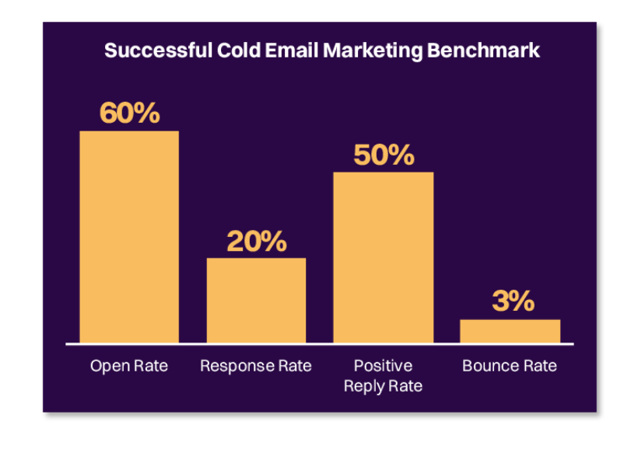- Home
- Email Tips and Tricks
- Cold Email A/B Testing: Essent ...

Let’s start with the definition of the concept of A/B testing concept when it comes specifically to cold emails in your marketing campaigns.
What Is A/B Testing in Cold Outreach?
As you know, A/B testing, or split testing, is a well-established method of comparing two marketing element versions to determine which performs better.
What is a cold email, then?
It is a first-ever email sent to a recipient without previous contact. We believe it is very important to understand that a cold email is not crafted to be a spam letter. It is meant to be a lead for more engagement.
Let’s see an example of a well-crafted cold email:
As you can see from the picture above, this cold email is very well structured. You can see the content elements, from the subject line to the intro to the CTA. A proper cold email is meant for the target audience. Otherwise, it won’t persuade the recipients, and they will send it directly to trash. A good cold email must also have personalization. The ultimate goal is, of course, business like sales or recruiting. It is a contemporary equivalent of a good old cold call. Yet, cold emailing is less intrusive, which is a psychological advantage.
As a cold email is not spam, the message must be tailored for the recipient so that the content won’t look alien to them. A cold email aims to get a reply as a start of marketing communication. You don’t sell anything directly at this point; instead, you’ll hook a potential customer by providing valuable content to the recipient.
However, you want to ensure that your cold outreach is adequately targeted and effective regarding your email marketing goals. So, this is when you need effective cold email testing. It is now time for A/B testing to come on stage.
In split testing, the marketer develops two versions of a cold email and sends them to a small slice of the target audience. The goal is to determine which variant performs better, delivering higher engagement metrics. A/B testing is meant to optimize your email content and improve engagement rates.
Why Is A/B Testing Essential in Cold Emails?
A/B testing is essential in cold outreach marketing campaigns. Split testing helps to reliably design a well-performing cold email that would achieve the marketer’s purposes. Let’s see in which areas A/B testing can improve cold email performance.
- Optimization: It is about identifying the email’s most efficient elements, such as subject lines, greetings, intro lines, copy, calls to action (CTAs), and design features.
- Personalization: This feature is crucial for cold outreach. Understanding what kind of personalization works better for different audience segments is essential. Using the A/B testing results, marketers can tailor their messages more effectively.
- Better engagement: A/B testing of different content elements in cold emails can significantly improve key metrics, such as open, click-through, and response rates.
- Data-driven decisions: You will get statistically proven data to develop and implement marketing decisions using the A/B testing email tool. Simply speaking, A/B testing helps to reduce reliance on wishful thinking and guesswork. Instead, it provides reliable and efficient action to take in engaging the target audience.
How to Apply A/B Testing to Your Cold Email Campaigns
Implementing split testing in your cold email campaigns involves several crucial elements:
- Set your objective: First of all, you must decide what you are going to split test. For example, you may target higher open rates or better reply rates.
- Create versions: Develop two variants of your cold email and make sure that there is one differing element. This can be the subject line, intro line, body text, or CTA. For instance, you may test CTA versions like “Bill, it is time to take action!” vs. “Bill, check out our latest offers!”
- Define a sample size: Selecting a small but statistically representative segment of your target audience is the crucial condition for a correct A/B testing.
- Send the emails: You’ve got a message! Sending the two versions to your selected sample is a technical job, but the timing of the send time matters.
- Evaluate results: When it is all said and done, it is time to analyze the performance based on your metrics, such as open rates, click-through rates, or response rates.
- The winner takes it all: When the better-performing email is defined, use this winning variation in your campaign and forget about the loser!
Key Elements You Should A/B Test in Your Cold Emails
When conducting A/B tests for cold outreach, consider testing the following email A/B testing ideas:
- Subject lines: Be creative! Try different lengths, tones, and personalization techniques. Mailshake, a popular U.S.-based sales and marketing blog, offers plenty of cold email subject lines to check out and evaluate. You can choose from personalized subject lines to casual ones to some rare creatives like share-a-secret subject lines. For instance, you can test an opinionated subject line like “The Last Samurai movie was a breakthrough in Tom Cruise’s career” vs. a subject line in urgency like “You don’t want to miss this milestone in Tom Cruise’s career!”
- Email body copy: Test variations in messaging, length, and structure. For example, you can experiment with a laconic email that gets straight to the point against an extensive, very informative email. The metrics to measure the target audience’s reaction would be response rates and engagement levels.
- Calls to action: Compare different CTAs to understand which drives more responses. A good CTA is a gateway for your audience to take action. So, it is essential to seal your message with an eye-catching and effective CTA. Don’t use more than one CTA per cold mail when considering your A/B testing. According to the specialized e-marketing Lemlist blog, emails with only one CTA have a 371% better open click rate than emails with multiple CTAs. So the recommendation is to A/B test one CTA vs. one CTA.
- Send times: Yes, timing matters in cold email marketing. You can test different days and times to find out the best schedule for sending your cold emails. For example, according to Convince&Convert, the best send time in the B2B area is around 10 a.m. However, in the B2C case, it is different. The best send time may vary based on your product’s target audience. In this case, you will definitely need an A/B testing to figure out the optimal schedule.
- Personalization: According to Yes Lifecycle Marketing, personalization can boost your open rate by 50%. The email A/B testing best practice would be trying various personalization techniques. For example, you can use the recipient’s name or mention specific details about their company if it is a B2B cold email testing.
How to Increase Your Cold Email Open Rates with A/B Testing
To supercharge your cold email open rates, focus on testing subject lines and sending times. An eye-catching subject line like “The client is always wrong: aren’t you?” can make an impact on the subscriber’s decision to open your email. Be brave to experiment with variations that include personalization: “Jane, can you spare a couple of minutes for us?” Try asking a provocative question in the subject line: “How many times do we have to tell you?” You can also spice up your content and make the recipient curious: “A horse walks into a pub…”
We recommend testing sending your emails at different times of the day and also sending emails on different weekday matters. These games with the schedule will help you identify when your target audience will most likely engage.
Let’s see some target rates in cold email marketing, according to RevNev, an American e-marketing company:

How to Increase Your Response Rates with A/B Testing
Improving response rates involves testing different email body copies and CTAs. Experiment with tones and content structures, such as super short CTAs against lengthy ones, to see which prompts the most responses.
For example, you can test an educational CTA like “Mind if I send you our cool short video on how we’ve got record sales?” against a conversation starter CTA: “Don’t you think this video would increase your sales?”
How to Increase Your Click-Through Rates with A/B Testing
To raise CTR, you should concentrate on the email content first. Also, think about the placement of your links and CTA positioning. You can also play with visual elements like testing different ways of presenting your links, such as text links versus buttons; in other words, a functional approach vs. a more artistic one. After all, it is all about the message and the structure of your cold email content. The recipient’s CTR reflects their perception of your content.
How to Generate More Leads by A/B Testing Your Cold Emails
Here’s a trick: nothing is stable in the world of marketing. Consumer behavior and patterns can change all the time. Your great content with a refined CTA worked fantastic two years ago. As people’s consumer views change, it may not perform so well anymore.
Cold emails can generate more leads by constantly reassessing your marketing approaches based on A/B test results. For example, you can achieve it by A/B testing different lead magnets like webinars, whitepapers, or free trials. Whichever offer performs better for your audience, use it. You can also experiment with follow-up sequences to determine the most effective lead generation schedule.
For example, you need a follow-up sequence strategy in two cases:
- when your recipients don’t reply to your initial cold email;
- when they did reply but weren’t persuaded and lost interest.
In both cases, you must develop an efficient follow-up strategy. The first step here would be to split test your follow-up sequences to determine which one works better.
Tools and Resources for Efficient A/B Testing
There are several global online platforms that can facilitate efficient A/B testing in cold email campaigns. Let’s see our recommended short list:
- Mailchimp: This email marketing and automation platform is known for its powerful A/B testing features for various cold email elements like subject lines, content, CTAs, and send times. Mailchimp claims to help its clients achieve higher open, click-through, and reply rates.
- HubSpot: The agency provides various tools for cold email A/B testing. They have a network of in-house-developed marketing hubs, like Sales Hub or Commerce Hub, to create 360-degree client service.
- Optimizely: This New York-based agency offers robust A/B testing and personalization features. Optimizely has developed advanced tools like its Content Marketing Platform for comprehensive cold email marketing campaigns, which include split testing.
- Litmus: The company’s motto is “say goodbye to broken emails and long review cycles.” Their Litmus Email Guardian tool has a 24/7 service for email monitoring, including A/B testing capabilities.
To Sum Up
In email marketing, your cold email strategy must be fresh and flexible. The reason is simple: your customers’ consumer patterns change constantly. A/B testing is a very efficient tool for monitoring these fluctuations and making necessary content corrections.
Using A/B cold email testing in your e-marketing campaigns can dramatically improve your metrics and achieve better results. A/B testing provides valuable insights to refine your marketing strategies, allowing you to develop more effective and personalized email outreach efforts.



